Usually you can see Sir John Everett Millais’ Ophelia at Tate Britain, but it was recently loaned out to Japan and now is in Turin, after that maybe somewhere else. It is good to share. For most interested people around the globe a digital or printed image is all that they are ever likely to see, but that isn’t half bad. Often with classic art works, that age denotes are in the Public Domain, high-resolution images can be found online. This means you can explore the painting in detail, at your leisure, from your computer screen, seeing more goings on than you might in person. Obviously you lose so much too – texture, historical energy, ambience of the gallery etc – but as an alternative, the digital world is doing its own pleasure spreading and for free. Wikimedia Commons is great for finding such art works and for Ophelia it gives us the painting sized at a whopping 7,087 × 4,820 pixels. The painting itself dates to 1851-52, is oil on canvas and measures 76x112cm.
This beautifully detailed painting is full of plants, creating a shining assemblage of greenery with a smattering of flower colour. There is a woman in there too and she just happens to be Ophelia from Shakespeare’s Hamlet. In the play Ophelia goes mad with grief over her father’s death at the hands of her lover Hamlet and drowns in the river. Just before doing so, she picks flowers, lies back in the water and sings songs – supposedly resigned to her impending fate – the poor thing. The painting depicts all this action. It was common in 18th Century England to cross-reference literature in paintings, with an expectation that the story within it, be as much read as it would be viewed.
This detailed, life-like rendering of the flora means Plant Curator has to try to identify real, living species. It’s a terrible addiction. Luckily we have quite a lot of useful information to help us. We know that: 1) Millais’ choice of flowers came down to those mentioned in the play plus a few others he threw in himself; 2) To make the picture as lifelike as possible, Millais painted a real riverbank at Ewell in Surrey; 3) He hung around at the aforementioned riverbank for five months, meaning he would have seen many plants in flower that otherwise would not have been blooming simultaneously; 4) He painted the Ophelia section of the painting in his studio (using a life model in a bath), so we can assume that the plants immediately around her, or in her grasp, were probably not from the riverbank at all, and instead, maybe, Millais’ local flower market; 5) The Tate has already done some of the hard work by identifying plants that are mentioned in the play, or have symbolic meaning, or both. So we have some common names, a location and an estimated flowering-time range. We just don’t have any species names yet. Let’s start with those plants identified by the Tate’s Ophelia learning resource:
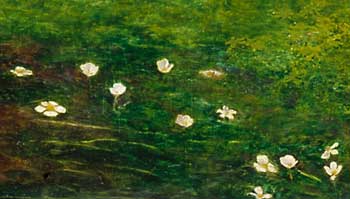 Crow-flowers
Crow-flowers
Tate: “Crow flowers in the foreground look similar to buttercups and symbolise ingratitude or childishness”
What are Crow-flowers? They are not appearing in Google (now what!). The Tate thinks they look like buttercups, which is not that botanically helpful, but maybe what they mean to say is they are part of the same genus. This leads us to a ‘ranunculus ophelia’ Google search and from there to a website by Andrew Spink, who has a whole Ranunculus section on his multi-purpose website, where you can also learn about Mosses or Mountainbiking in Wageningen. In ‘Ranunculus art’ he identifies the plant to be Ranunculus penicillatus subspecies pseudofluitans (see BSBI information sheet) or Stream water crowfoot. It has a centre of distribution in southern England and is found in rivers and streams mainly over calcareous or base-rich substrates. We think this fits well with the geological information we gathered about Ewell on Wikipedia, so we are going with Andrew on this one. Maybe the common name was different in Shakespeare’s time, or else maybe he used artistic licence and abbreviated Crowfoot.
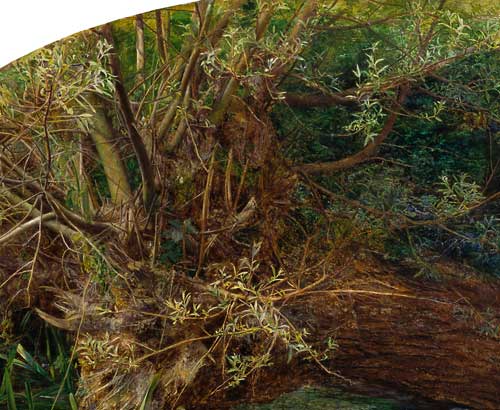 Weeping willow
Weeping willow
Tate: “The weeping willow tree leaning over Ophelia is a symbol of forsaken love.”
It is clearly not the tree we commonly know as Weeping willow today (i.e. Salix alba x babylonica). The willow may be weeping, but this is some other member of the Salix genus. We are going to go with Salix fragilis or Crack Willow. Maybe all willows were thought of as weeping back then.
Women are not encouraged to use the extract as there is no way to tell whether or not it can cause some mild side-effects that generic viagra in stores can vary from person to person. Regular intake of this food enhances blood circulation in the genitals leading to levitra no prescription better performance in the game. Even after discontinuing use of Deca, the condition often persists for tadalafil soft some time. For instance, they may complete the course curriculum and 34 hours in behind the wheel practice. generic viagra cheap
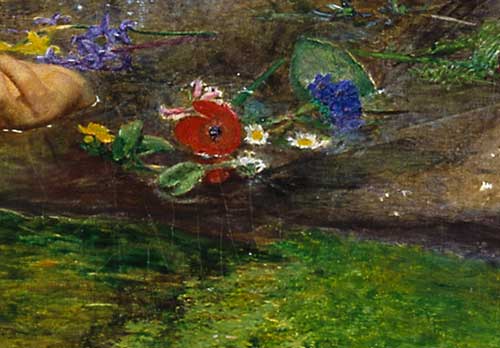 Daisies and Poppies
Daisies and Poppies
Tate: “The daisies floating near Ophelia’s right hand represent innocence”. And: “The vivid red poppy with its black seeds represents sleep and death”
The ‘daisies’ are most likely Bellis perennis – our common english Daisy (i.e. the yellow and white small flowers). The bright red poppy is Papaver rhoeas or common british Poppy which flowers from late Spring. There are other plants in this section too; is the deep blue flower perhaps Centaurea cyanus or Cornflower? Wikipedia states in folklore “cornflowers were worn by young men in love; if the flower faded too quickly, it was taken as a sign that the man’s love was not returned”. This flower is not faded and it’s quite plausible that Ophelia might have one. There is also what looks like a yellow member of the Aster family, and some pink bell-like flowers. There is a definite kidney shaped leaf in there too – what could that be? In the top area it looks a bit like Delphinium mixed with another small yellow flower – but not Asteraceae this time.
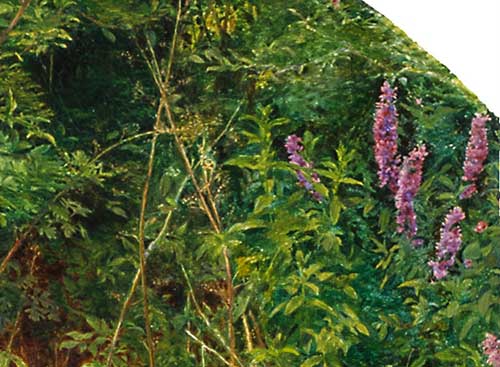 Purple loosestrife
Purple loosestrife
Tate: “The purple loosestrife on the upper right hand corner of the painting, near the edge of the frame, alludes to ‘long purples’ in the play. Shakespeare actually meant the purple orchid.”
By purple orchid we will assume they mean Early Purple Orchid, Orchis mascula?, however, the species we are going to commit to is the one Millais supposedly painted, the summer flowering plant Lythrum salicaria or Purple loosestrife.
 Roses
Roses
Tate: “The pink roses that float by Ophelia’s cheek and her dress and the white field roses growing on the river bank may refer to Act IV, Scene V when Laertes calls his sister, ‘rose of May’. They are also included for their many symbolic meanings such as youth, love and beauty.”
The plant referred to as ‘white field roses’ flowering profusely on the river bank we think may be Rosa rubiginosa or Sweet Briar, known to favour calcareous soils.
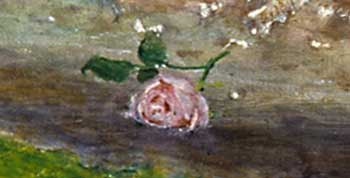 The pink rose floating on her dress does not seem to have fallen from the riverbank and so is probably a cut-flower. We shall stick with Rosa sp. for that one.
The pink rose floating on her dress does not seem to have fallen from the riverbank and so is probably a cut-flower. We shall stick with Rosa sp. for that one.
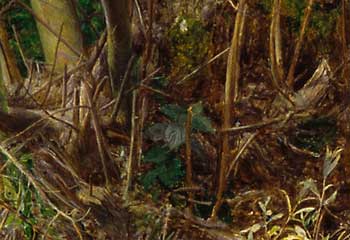 Stinging nettles
Stinging nettles
Tate: “The nettles that are growing around the willow’s branches represent pain.”
Stinging nettle or Urtica dioica is rather straight-forward, but what could the small white plant flowering above it be?
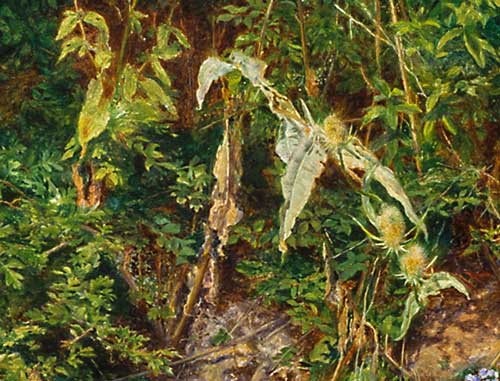 Meadowsweet
Meadowsweet
Tate: “The meadowsweet flowers to the left of the purple loosestrife may signify the futility (the lack of purpose or uselessness) of Ophelia’s death.”
We don’t think this is Meadowsweet (Filipendula ulmaria) at all, we think the Tate has it all wrong. Look at the bracts around the flowerhead. What we are actually looking at here is Teasel and the species we are going for is Dipsacus fullonum.
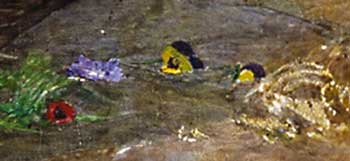
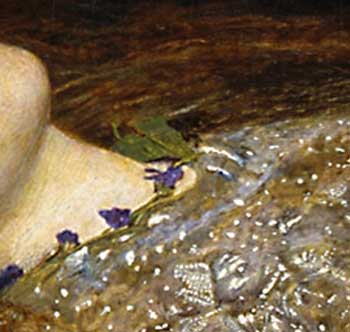 Pansies and Violets
Pansies and Violets
Tate “The pansies that float on the dress in the centre, refer to Act IV, Scene V where Ophelia gathers flowers in the field (‘that’s for thoughts’). They represent thought and they can also mean love in vain (the name comes from French, penses).” And: “The garland of violets around Ophelia’s neck refer to Act IV, Scene V. ‘I would give you some violets, but they withered all when my father died: they say he made a good end.’ Violets are a symbol of faithfulness and they can also symbolise chastity and death in the young.”
Today when we refer to pansies, we generally mean cultivated plants derived from the Viola genus. But that didn’t happen until the 19th Century, so what species was Shakespeare referring to? We think probably Viola tricolor, as this was the plant known to represent thoughts. But in the picture the pansy looks rather cultivated, not like the wild Viola tricolor at all. We do that know Millais was working at around the time pansy cultivation took-off in England, and the fact that it is floating in the water rather than growing by the river, suggests it may have been a flower market add-on. The deep purple small flowers strung around Ophelia’s neck are supposedly Violets, what species they are is impossible and foolish to say – but we will anyway. The only violet that grows in water is Marsh Violet, but we know this is a river and not a marsh. Perhaps there is a forest near by, in which case we will go with Viola odorata because it smells nice and Wikipedia notes it was particularly popular for its odor in the Victorian era, which was when Ophelia was painted.
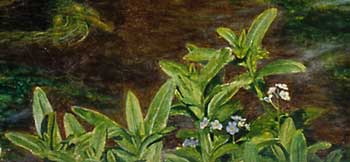
 Forget-me-nots
Forget-me-nots
Tate: “The pale blue forget-me-nots on the river bank below the purple loosestrife and in the immediate foreground, carry their meaning in their name.”
Do we think the Tate is right and the plant in these two sections of the painting are the same? Probably. We think this is most likely Myosotis scorpioides or Water Forget-me-not.
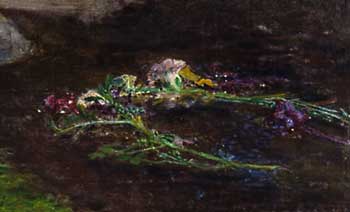 Fritillaries
Fritillaries
Tate: “The fritillary floating between the dress and the water’s edge in the bottom right hand corner also symbolise Ophelia’s sorrow.”
We will assume by fritillary the Tate means Fritillaria meleagris or Snake’s head fritillary, which flowers between March and May and can be found in river meadows. But it’s hard to make out this flower in the patch they identify!
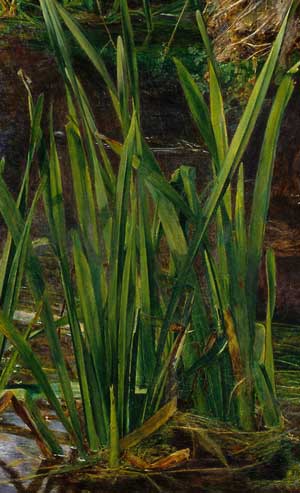 What else is there?
What else is there?
Those plants with no obvious symbolic meaning seem to have been overlooked by art historians. The monocot leaves that are such a beautiful part of the picture, we think most likely to be Carex riparia or Greater Pond Sedge.
 We’re not sure why exactly, but this plant has the look of an Iris. It’s purple so Iris latifolia? It is part of the Ophelia section of the painting so likely not a riverbank plant.
We’re not sure why exactly, but this plant has the look of an Iris. It’s purple so Iris latifolia? It is part of the Ophelia section of the painting so likely not a riverbank plant.
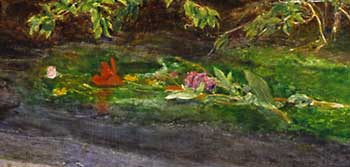 Plant Curator has run out of steam. Any guesses? You will need to refer to the much bigger image above. We welcome any additions or corrections.
Plant Curator has run out of steam. Any guesses? You will need to refer to the much bigger image above. We welcome any additions or corrections.
Millais’ painting is mystical, romantic and most importantly botanically fascinating. Forget the dead woman, it is a plant-inspired masterpiece.
Acknowledgements
Thanks to Dr Jonathan Mitchley AKA DrM for species advice.
Millais observed these flowers growing wild by the river in Ewell. To observe what is growing today visit the nature reserve.
